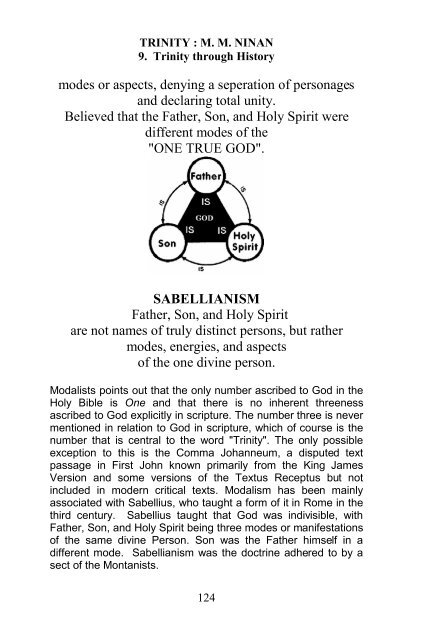Christian Understanding of Trinity3
You also want an ePaper? Increase the reach of your titles
YUMPU automatically turns print PDFs into web optimized ePapers that Google loves.
TRINITY : M. M. NINAN<br />
9. Trinity through History<br />
modes or aspects, denying a seperation <strong>of</strong> personages<br />
and declaring total unity.<br />
Believed that the Father, Son, and Holy Spirit were<br />
different modes <strong>of</strong> the<br />
"ONE TRUE GOD".<br />
SABELLIANISM<br />
Father, Son, and Holy Spirit<br />
are not names <strong>of</strong> truly distinct persons, but rather<br />
modes, energies, and aspects<br />
<strong>of</strong> the one divine person.<br />
Modalists points out that the only number ascribed to God in the<br />
Holy Bible is One and that there is no inherent threeness<br />
ascribed to God explicitly in scripture. The number three is never<br />
mentioned in relation to God in scripture, which <strong>of</strong> course is the<br />
number that is central to the word "Trinity". The only possible<br />
exception to this is the Comma Johanneum, a disputed text<br />
passage in First John known primarily from the King James<br />
Version and some versions <strong>of</strong> the Textus Receptus but not<br />
included in modern critical texts. Modalism has been mainly<br />
associated with Sabellius, who taught a form <strong>of</strong> it in Rome in the<br />
third century. Sabellius taught that God was indivisible, with<br />
Father, Son, and Holy Spirit being three modes or manifestations<br />
<strong>of</strong> the same divine Person. Son was the Father himself in a<br />
different mode. Sabellianism was the doctrine adhered to by a<br />
sect <strong>of</strong> the Montanists.<br />
124


















